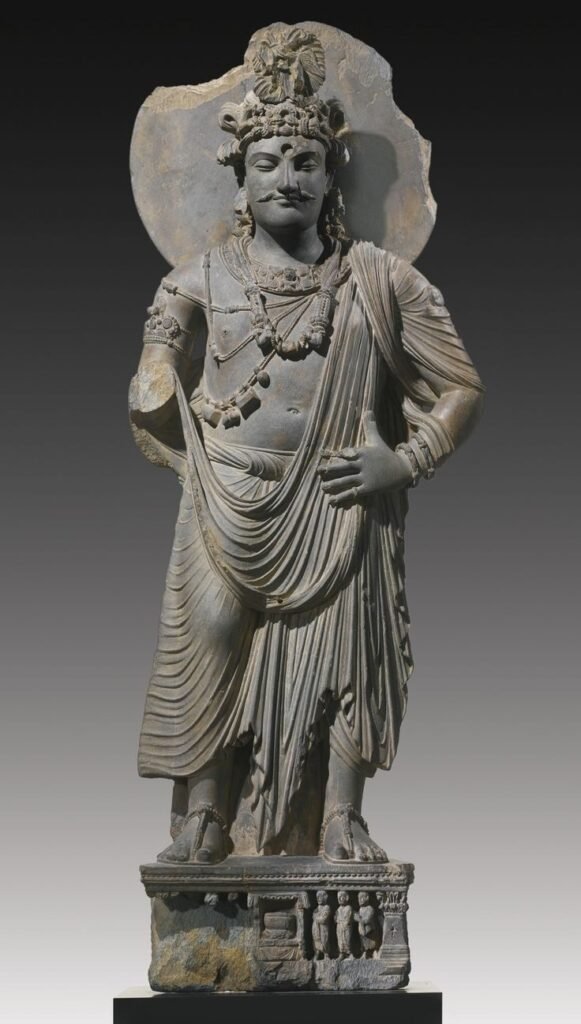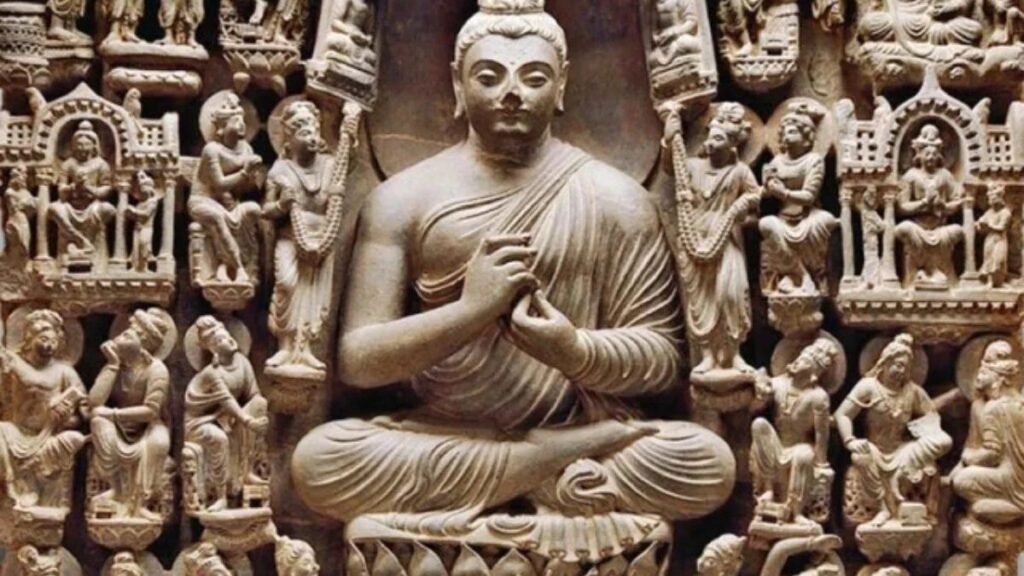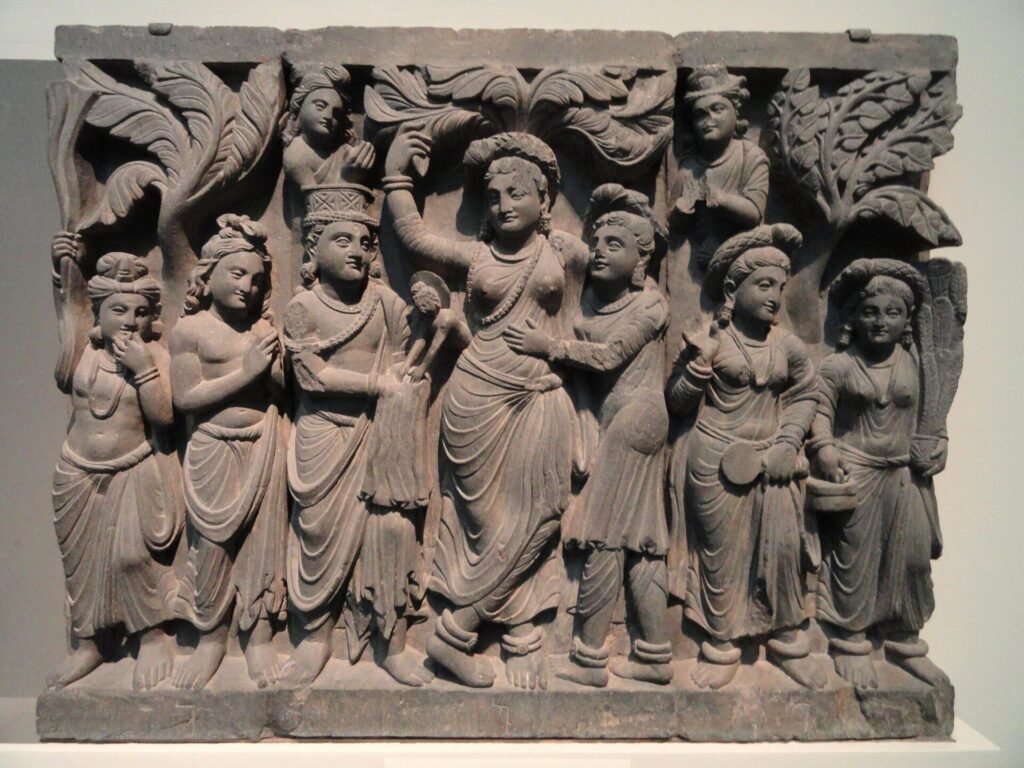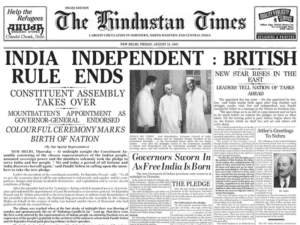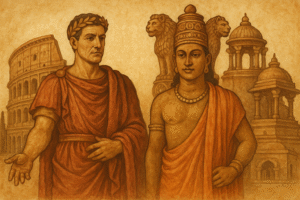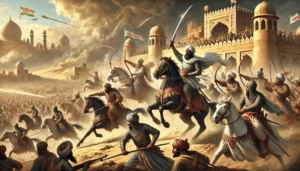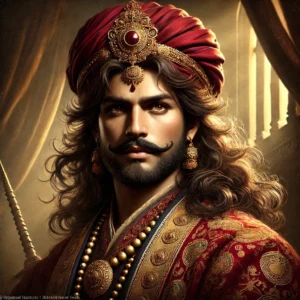Kushan Empire
In the ancient world, several empires connected far-reaching civilizations, creating networks of trade, religion, and culture. One of the most fascinating, yet often overlooked, is the Kushan Empire. Flourishing between the 1st and 3rd centuries CE, the Kushans created a bridge between Central Asia, India, and the Greco-Roman world, playing a pivotal role in the development of Buddhism and shaping the ancient Silk Road. This article explores the history, culture, and legacy of the Kushan Empire—a dynamic force that connected East and West in the ancient world.
1. Who Were the Kushans?
The story of the Kushans begins in Central Asia, where they were originally part of a larger group known as the Yuezhi, a nomadic people from the eastern steppes near modern-day China. In the 2nd century BCE, the Yuezhi were displaced by the powerful Xiongnu, another nomadic tribe, forcing them to migrate westward. Over time, the Yuezhi settled in Bactria, a region corresponding to modern-day Afghanistan and Tajikistan, which was rich in Greek influence after the campaigns of Alexander the Great.

Among the five Yuezhi tribes, one emerged as dominant: the Kushans. Their leader, Kujula Kadphises, united the Yuezhi and established what would become the Kushan Empire around the 1st century CE. Under his reign, the Kushans expanded their influence into northern India and consolidated their hold over Central Asia, setting the stage for an empire that would rival the most powerful kingdoms of the ancient world.
2. Cities, Capitals, and the Geography of the Empire
The Kushan Empire covered a vast and diverse region, from the mountainous terrain of Central Asia to the fertile plains of northern India. The empire’s geographic spread made it one of the most significant powers in the ancient world, controlling key territories along the Silk Road, the ancient trade route that linked China to the Roman Empire.
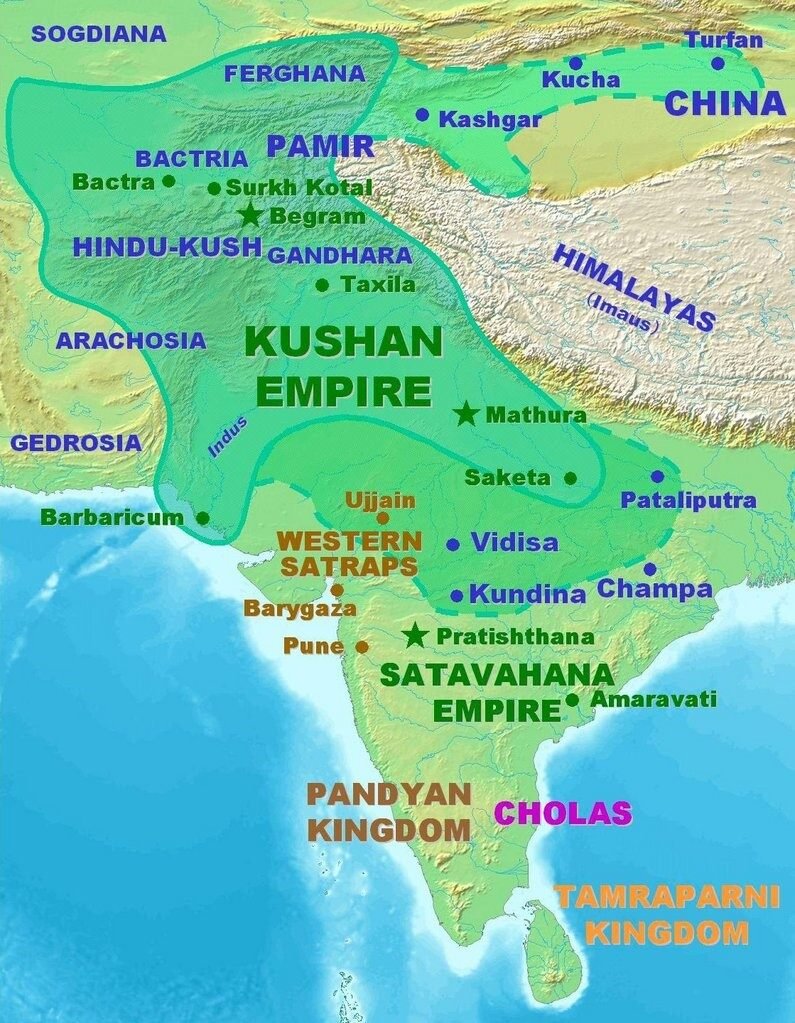
Key Cities and Capitals:
- Bactria: The first capital of the Kushan Empire was Bactria, a region that had been a cultural and commercial hub for centuries. The city of Balkh (modern-day Afghanistan) served as a critical center for early Kushan power.
- Kapisa: Located near modern Kabul, Kapisa served as an early Kushan capital and a critical center of trade and culture.
- Purushapura: Later, under the great ruler Kanishka, the capital moved to Purushapura (modern-day Peshawar in Pakistan). This city became a thriving metropolis and the heart of Kushan rule. It was a significant cultural hub, home to one of the largest Buddhist stupas of the ancient world—the Kanishka Stupa.
- Mathura: In northern India, the city of Mathura emerged as a vital center of Kushan administration and culture. Known for its religious significance in both Buddhism and Hinduism, Mathura became a focal point of Kushan art and architecture.
- Taxila: Another crucial city in the empire, Taxila (in modern Pakistan), was a renowned center of learning and culture. Its universities attracted scholars from across the ancient world, and the city played a vital role in connecting the eastern and western regions of the Kushan Empire.
- Begram: Also known as Kapisa, Begram was a significant summer capital of the Kushan kings. The archaeological finds from Begram, including Roman glass, Chinese lacquerware, and Indian ivories, reflect the empire’s cosmopolitan nature and its key role in ancient global trade.
This network of cities allowed the Kushans to control a strategic portion of the Silk Road, facilitating trade between China, India, Persia, and the Roman Empire.
3. The Golden Age: Emperor Kanishka
The Kushan Empire reached its zenith under the rule of Emperor Kanishka the Great, who ascended to the throne around 127 CE. Kanishka is remembered as one of the greatest rulers of the ancient world, celebrated for his military prowess, his patronage of Buddhism, and his efforts to promote cultural and religious exchange.

Under Kanishka’s leadership, the Kushan Empire expanded to its greatest extent, stretching from Central Asia across the Indus River and deep into northern India, encompassing territories as far east as Pataliputra (modern Patna in India). Kanishka’s empire became a significant player in international trade and diplomacy, making the Kushan Empire a key bridge between the East and West.
Kanishka’s reign is also notable for his support of Mahayana Buddhism, a new and influential branch of Buddhism that emphasized the potential for all beings to achieve enlightenment. Under Kanishka’s patronage, Buddhism flourished, and he convened the Fourth Buddhist Council in Kashmir, which played a crucial role in codifying Mahayana Buddhist doctrine. This council, composed of monks and scholars, helped shape the future of Buddhism and contributed to its spread throughout Central Asia and China.
4. The Kushans and the Silk Road
The Silk Road was one of the most important trade routes in the ancient world, linking China to the Mediterranean. The Kushan Empire, strategically located along the central portion of this route, played a key role in facilitating the movement of goods, ideas, and cultures.
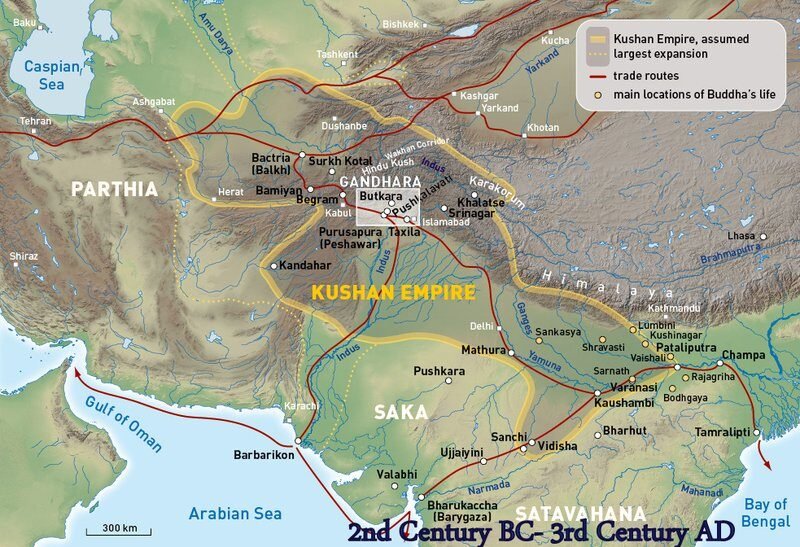
Goods that traveled through Kushan territory included:
- Silk from China.
- Spices, textiles, and precious stones from India.
- Glassware, wine, and metals from the Roman Empire.
However, the Silk Road wasn’t just a route for material goods; it also facilitated the spread of ideas and religions. Buddhist monks, scholars, and merchants carried Buddhist teachings along the trade routes into Central Asia, China, and beyond. The Kushans played a critical role in this process, promoting Buddhist art and literature and allowing the religion to flourish in new regions.
The trade and cultural exchanges along the Silk Road significantly enriched the Kushan Empire, contributing to its economic prosperity and cultural diversity. The Kushan rulers issued gold coins, which bore inscriptions in Greek and Bactrian, highlighting their ties to the Hellenistic world and their control over vast economic networks.
5. Cultural and Religious Influence
The Kushan Empire was renowned for its cultural diversity and religious tolerance. It served as a meeting point for Greek, Indian, Persian, and Central Asian influences, creating a vibrant and cosmopolitan society. This diversity was reflected in Kushan art, religion, and coinage. The Kushan kings often portrayed themselves as divine figures, embodying both Buddhist and Hindu ideals of kingship.

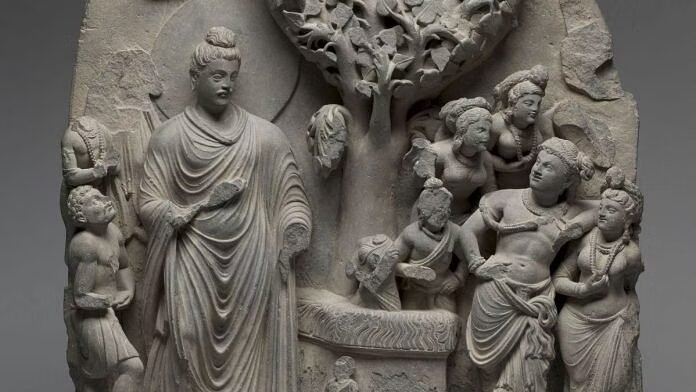
Religious Pluralism:
- Buddhism: The Kushans, particularly under Kanishka, were great patrons of Buddhism, helping to spread the religion far beyond India. They built Buddhist stupas and supported monasteries throughout their empire. The Kanishka Stupa in Peshawar was one of the largest Buddhist monuments in the world, and Kushan kings issued coins featuring Buddhist symbols and imagery.
- Hinduism: While Buddhism was prominent, the Kushans also respected and supported Hindu traditions. The city of Mathura, for example, was a center of both Buddhist and Hindu culture.
- Zoroastrianism: In the western parts of the empire, Zoroastrian influences were strong, reflecting the Persian religious traditions that predated the Kushans’ arrival.
- Hellenistic Influence: Due to the Greek presence in Bactria and Central Asia, many aspects of Greek religion and culture continued to thrive under Kushan rule. Greek gods appeared on Kushan coinage, and the influence of Hellenistic art was especially visible in the Gandhara region.
6. Kushan Art and Architecture
One of the Kushan Empire’s most lasting contributions was its art and architecture, particularly the development of the Gandhara School of Art. Located in modern Pakistan and Afghanistan, Gandhara art is a remarkable fusion of Greco-Roman and Indian styles, producing some of the earliest and most iconic representations of the Buddha in human form. Prior to this period, the Buddha had been represented in symbolic forms such as a wheel or a footprint.
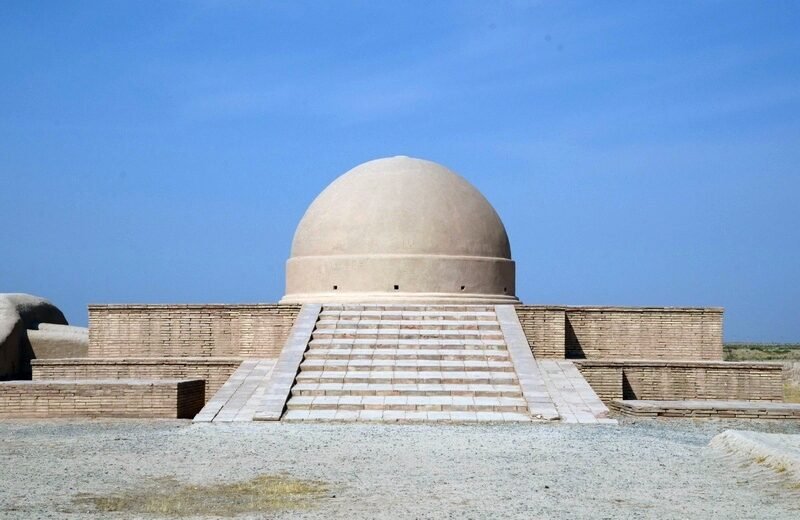
Gandhara Art Highlights:
- Sculptures of the Buddha depicted in Greco-Roman drapery, combining the realistic portrayal of the human body seen in classical Greek art with the spiritual themes of Buddhism.
- Reliefs and frescoes that depicted scenes from the life of the Buddha, including his birth, enlightenment, and death, using a blend of Greek and Indian artistic techniques.
The Kushans were also great builders, constructing Buddhist monasteries, temples, and stupas. The Kanishka Stupa in Purushapura was one of the most magnificent Buddhist structures of its time, towering over 600 feet high, making it a major pilgrimage site.
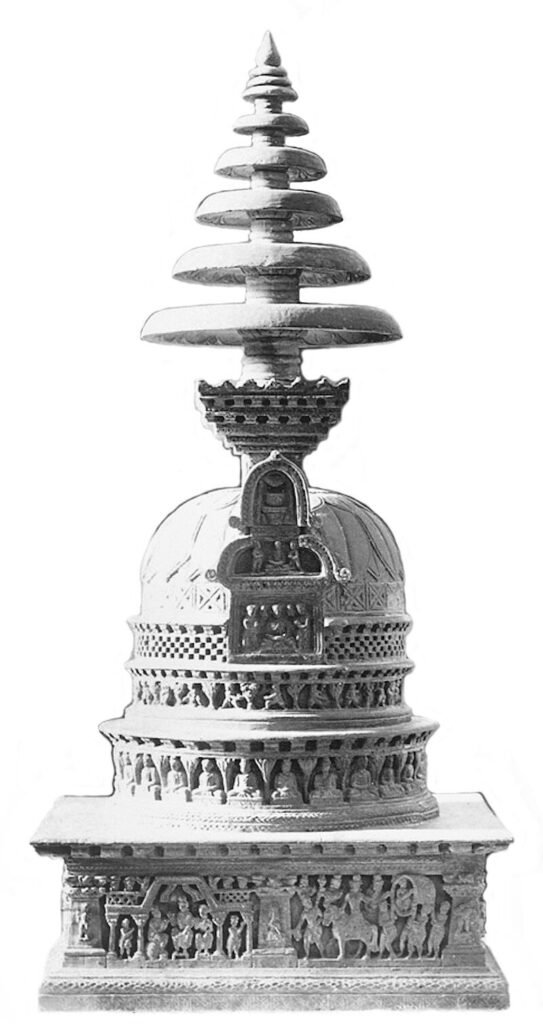
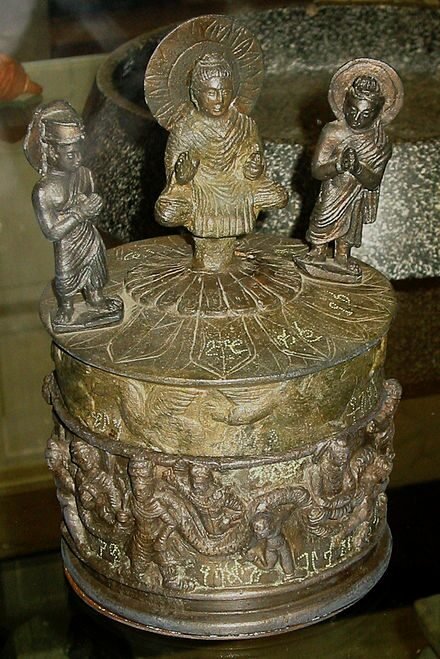
7. Languages Spoken in the Kushan Empire
The Kushan Empire was a linguistically diverse realm due to its vast and multicultural territories, with several languages spoken across different regions:

- Bactrian: The primary administrative language, an Eastern Iranian language written in the Greek script, reflecting the lingering Hellenistic culture in Bactria.
- Greek: Used on early Kushan coins and inscriptions, especially in the empire’s western regions, though it was gradually replaced by Bactrian.
- Prakrit: Widely spoken in the empire’s Indian territories and written in Kharosthi or Brahmi scripts; commonly used for everyday communication and in official inscriptions.
- Sanskrit: Used primarily in religious texts and during Kanishka’s reign, especially for Buddhist scriptures and Hindu practices.
- Gandhari: A local language spoken in Gandhara, written in Kharosthi, and used in Buddhist texts. It played a major role in the spread of Buddhism along the Silk Road.
- Saka/Scythian: Spoken by nomadic groups in Central Asia, reflecting the empire’s Iranian heritage.
- Tocharian: Spoken on the eastern frontiers of the empire, particularly in the Tarim Basin.
This multilingualism was a testament to the Kushans’ role as a cultural and commercial hub along the Silk Road, connecting various regions and peoples.
8. The Decline of the Kushans
The Kushan Empire began to decline in the 3rd century CE. Several factors contributed to its downfall:
- Internal strife and succession disputes weakened the central authority.
- The rise of the Sassanian Empire in Persia posed a significant external threat, leading to the loss of western territories.
- The emergence of the powerful Gupta Empire challenged Kushan control in the east, gradually eroding their influence.
By the mid-3rd century CE, the empire had fragmented into smaller regional kingdoms. Despite its decline, the Kushans left a profound legacy, particularly in their promotion of Buddhism, their role in the Silk Road trade, and their contributions to art and culture.
9. Why Should We Remember the Kushans?
Although the Kushan Empire may not be as widely known as ancient Rome or Egypt, its contributions to world history are immense. The Kushans were instrumental in spreading Buddhism across Asia, helping to shape the religious and cultural landscape of the ancient world. Their cities, such as Peshawar, Mathura, and Taxila, were centers of learning, art, and commerce, influencing generations of scholars, artists, and traders.
The Kushans’ strategic position along the Silk Road made them a vital link between East and West, facilitating not only the exchange of goods but also the spread of ideas and technologies. Their empire was a true melting pot of cultures, blending Greek, Indian, Persian, and Central Asian traditions in ways that enriched both the ancient and modern worlds.
In many ways, the Kushan Empire can be seen as an early example of globalization, connecting distant civilizations through trade, culture, and religion. Though their empire has long since faded, the Kushans’ legacy endures, reminding us of the interconnectedness of the ancient world.

